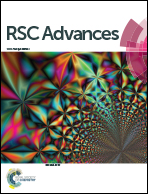Role of para-substitution in controlling phosphatase activity of dinuclear NiII complexes of Mannich-base ligands: experimental and DFT studies†
Abstract
With an aim to study the electronic effect of the group lying in the para-position of phenol-based compartmental Mannich-base ligands, five dinuclear nickel(II) complexes [Ni2L1−5(μ-NO3)(NO3)2] have been synthesized [R = Me (1), CHMe2 (2), CMe3 (3), Cl (4), and OMe (5)] having octahedral structures (fac-manner) in each case as confirmed by single-crystal X-ray diffraction (1–4). The Ni⋯Ni distance (3.42–3.49 Å) and Ni–O–Ni bridging bond angle (118.62–121.45°) of 1–4 is proportional to the electronic partial charge (I-effect) of the para-substituents as 3 < 2 ≈ 1 < 4. The phosphatase activity has been studied with the phosphomonoester 4-nitrophenylphosphate (4-NPP) in aqueous DMSO by spectrophotometry leading to the trend 3 > 2 > 5 > 1 > 4 in terms of kcat values (6–81 s−1), as per the Michaelis–Menten profile. DFT calculations establish that the electron-donating group decreases the reaction energy barrier via reducing the energy gap between the orbital of electron-sufficient para-substituted phenolate group and the electron-demanding leaving group. The exceptionally high activity of complex 3 also establishes the rationality of our catalyst design in our previous work (Inorg. Chem. 2015, 54, 2315–2324).


 Please wait while we load your content...
Please wait while we load your content...